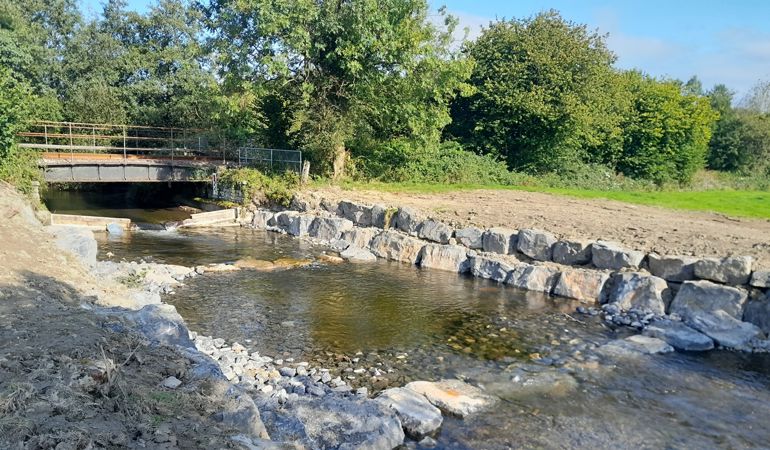Restoring migratory fish routes on the Afon Dulais

A project to restore the River Dulais near Llanwrda and open up spawning grounds for migratory fish has been completed.
Natural Resources Wales’ (NRW) Four Rivers for LIFE project team has completed a fish passage on a structure under a railway bridge on the Afon Dulais, a tributary of the Tywi River SAC.
Shallow flows over the 14metre long bridge apron under the bridge, along with a vertical height difference of over 30cm, created a significant barrier to fish migration.
The Afon Dulais is an important spawning tributary for fish such as Atlantic salmon and sea trout and the location of the barrier at the bottom of the catchment limited access to approximately 14km of habitat upstream.
The fish passage comprised of pre-barrages - small dams made from block stone - to raise the water level downstream, thereby reducing the difference in water height.
Oak baulks (square timber beams) were installed on the downstream edge of the bridge apron to increase water depth on the apron surface.
A ramp fitted with studded tiles was also fitted through one of the baulks to improve passage for weaker swimming species such as eel and lamprey.
This new scheme will maximise benefits of a fish pass delivered by NRW in 2023 at a weir upstream in Llanwrda village.
Further work is planned to improve fish passage on the Afon Dulais in 2025. This work will include the installation of a rock ramp at a weir near the A40 road bridge.
Peter Jones, Four Rivers for LIFE Officer said: “The combined benefits of these schemes should achieve uninterrupted access for migratory fish on the Afon Dulais.
“It is crucial that we open up fish access to tributaries to help reverse the decline in salmon and sea trout populations. It is also critical that fish passage improvements reflect the needs of weaker swimming fish such as eel and lamprey.”
The project was designed and delivered by Paul’s Plant Hire and took just three weeks to complete.
The scheme was paid for by the EU LIFE Programme funded Four Rivers for LIFE Project.
To find out more about the project please visit the website Natural Resources Wales / Four Rivers for LIFE
